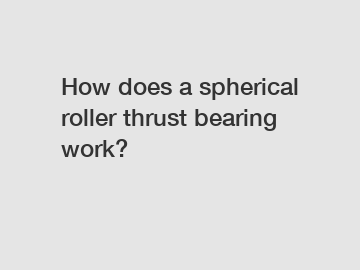How does a spherical roller thrust bearing work?
How does a spherical roller thrust bearing work?
A spherical roller thrust bearing is a critical component in many mechanical systems. It is designed to accommodate high axial loads while also being able to handle some radial loads. This type of bearing consists of multiple rows of barrel-shaped rollers, held together by a cage, and is capable of supporting heavy loads in both directions.
To understand how a spherical roller thrust bearing works, it is essential to explore its construction and key features. Here are the main points to consider:

1. Construction: A spherical roller thrust bearing consists of two washers, which are called raceways, an inner ring, an outer ring, barrel-shaped rollers, and a cage. The raceways contain grooves where the rollers are positioned, and the cage keeps the rollers separated and evenly spaced. The inner and outer rings provide support and maintain the bearing's overall structure.
2. Self-aligning feature: One of the unique characteristics of a spherical roller thrust bearing is its ability to self-align. The barrel-shaped rollers are not positioned parallel to the axis; rather, they are oriented at an angle. This configuration allows the bearing to compensate for any misalignment or deflection that may occur during operation. The self-aligning feature reduces stress on the bearing and helps maintain its efficiency and longevity.
3. Load distribution: The barrel shape of the rollers enables the bearing to distribute loads more evenly compared to other bearing types. This is particularly advantageous when dealing with heavy axial loads. As the load is applied, the rollers rotate, distributing the force along their length. This improves load-carrying capacity, reduces friction, and minimizes the risk of premature wear or failure.
4. Lubrication: Proper lubrication is crucial for the smooth operation and longevity of spherical roller thrust bearings. The lubricant forms a film between the rolling elements and raceways, preventing metal-to-metal contact and minimizing friction and wear. Additionally, lubrication helps dissipate heat generated by the bearing during operation, ensuring it remains within the optimal temperature range.
5. Axial and radial load handling: Spherical roller thrust bearings are primarily designed to accommodate axial loads, meaning they can withstand forces applied in the direction of the bearing's axis. However, they also have the ability to handle some radial loads, which makes them versatile in various applications. The combination of high axial load capacity and moderate radial load handling further expands their application range.
In conclusion, a spherical roller thrust bearing is a highly efficient and versatile component designed to withstand heavy axial loads while accommodating some level of radial loads. Its self-aligning feature, load distribution capabilities, and proper lubrication contribute to its reliability and longevity. This type of bearing plays a critical role in various mechanical systems, including heavy machinery, automotive applications, and industrial equipment. Understanding the inner workings of a spherical roller thrust bearing helps ensure proper selection, installation, and maintenance, ultimately optimizing its performance and extending its service life.
For more Quality Features to Look for in Thrust Bearings, Top Ball Bearing Manufacturers, Trusted Thrust Bearings Manufacturerinformation, please contact us. We will provide professional answers.


